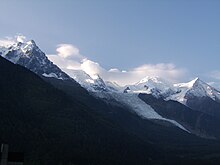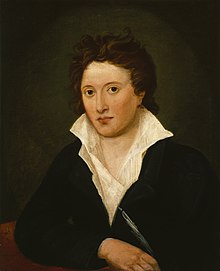This is an old revision of this page, as edited by Wadewitz (talk | contribs) at 20:03, 8 October 2008 (→Background: changing note to Tour ref). The present address (URL) is a permanent link to this revision, which may differ significantly from the current revision.
Revision as of 20:03, 8 October 2008 by Wadewitz (talk | contribs) (→Background: changing note to Tour ref)(diff) ← Previous revision | Latest revision (diff) | Newer revision → (diff)
"Mont Blanc: Lines Written in the Vale of Chamouni" is an ode by the Romantic poet Percy Bysshe Shelley composed between 22 July 1816 and 29 August 1816 during a journey he took to the Chamonix Valley. It was first published in 1817 in History of a Six Weeks' Tour through a Part of France, Switzerland, German and Holland by Percy Shelley and Mary Shelley. "Mont Blanc" compares the power of the mountain to that of the human imagination.
Background

Percy Shelley started writing "Mont Blanc" at the end of July 1816, when he, Mary Godwin, and Claire Clairmont (Mary Godwin's half-sister by marriage), were touring the Chamonix Valley and visited Mont Blanc, Europe's highest mountain. Shelley finished a draft of the poem before September, and it was first published in 1817 as part of the Shelleys' travel narrative History of a Six Weeks' Tour. The published edition was not based on the first finished copy of Shelley's poem, but on a second created after Shelley lost the first. The first manuscript copy, which contains many differences from the first published edition, was discovered in December 1976.
Inspired to write the poem by the scenery surrounding a bridge over the Arve River in the Valley of Chamonix in Savoy, near Geneva, Shelley set the poem in a similar landscape. He wrote that the poem "was composed under the immediate impression of the deep and powerful feelings excited by the objects which it attempts to describe; and, as an undisciplined overflowing of the soul, rests its claim to approbation on an attempt to imitate the untamable wilderness and inaccessible solemnity from which those feeling sprang". Later, he described the mountains in general when he wrote, "The immensity of these aerial summits excited when they suddenly burst upon the sight, a sentiment of extatic wonder, not unallied to madness."
Poem
"Mont Blanc" is a 144-line natural ode divided into five stanzas and marked with irregular rhyme. It serves as Shelley's response to William Wordsworth's Tintern Abbey and as a "defiant reaction" against the "religious certainties" of Samuel Taylor Coleridge's "Hymn before Sun-rise, in the Vale of Chamouni", which "credits God for the sublime wonders of the landscape".
When the narrator of the poem looks upon Mont Blanc, he is unable to agree with Wordsworth that nature is benevolent and gentle. Instead, the narrator contends that nature is a powerful force:
- "The everlasting universe of things
- Flows through the mind, and rolls its rapid waves,
- Now dark - now glittering - now reflecting gloom -
- Now lending splendour, where from secret springs
- The source of human thought its tribute brings
- Of waters" - (Lines 1–5)
However, this force only seems to have power in relation to the human mind.
In the second stanza, the narrator turns to the Arve River as a representation of consciousness in nature. The Arve River and the ravine surrounding the river increase the beauty of the other:
- awful scene,
- Where the Power in likeness of the Arve comes down
- From the ice gulphs that gird his secret throne,
- Bursting through these dark mountains like the flame
- Of lightning through the tempest;" (Lines 15–19)
When the narrator witnesses the power of the Arve River, he claims:
- I seem as in a trance sublime and strange
- To muse on my own separate phantasy,
- My own, my human mind, which passively
- Now renders and receives fast influencings,
- Holding and unremitting interchange
- With the clear universe of things around; (Lines 35–40)
He realizes that knowledge is a combination of sensory perceptions and the ideas of the mind. The river can then serve as a symbol of a conscious power and a source for imaginative thought when he finishes the stanza, "thou art there!"
The third stanza introduces the connections between Mont Blanc and a higher power:
- Far, far above, piercing the infinite sky,
- Mont Blanc appears, - still, snowy, and serene -
- Its subject mountains their unearthly forms
- Pile around it, ice and rock; broad vales between
- Of frozen floods, unfathomable deeps,
- Blue as the overhanging heaven, that spread
- And wind among the accumulated steeps; (Lines 60–66)
Although the power may seem removed from mankind, it can still serve as a teacher. By listening to the mountain, one can learn that nature can be both benevolent and malevolent; good and evil emerge from conscious choice and one's relationship to nature:
- The wilderness has a mysterious tongue
- Which teaches awful doubt, or faith so mild,
- So solemn, so serene, that man may be
- But for such faith with nature reconciled;
- Thou hast a voice, great Mountain, to repeal
- Large codes of fraud and woe; not understood
- By all, but which the wise, and great, and good
- Interpret, or make felt, or deeply feel.(Lines 76–83)
The fourth stanza discusses the greater power behind the mountain:
- Power dwells apart in its tranquillity
- Remote, serene, and inaccessible:
- And this, the naked countenance of earth,
- On which I gaze, even these primæval mountains
- Teach the adverting mind. (Lines 96–100)
The power of the mountain, which encompasses both creation and destruction, parallels the power of the imagination.
Although nature can teach one about the imagination and offer truths about the universe, the poem denies the existence of natural religion. The power of the universe is symbolized by Mont Blanc, but for that power to have any meaning, one must exercise the imagination:
- Mont Blanc yet gleams on high: - the power is there,
- The still and solemn power of many sights,
- And many sounds, and much of life and death.
- The secret strength of things
- Which governs thought, and to the infinite dome
- Of heaven is as a law, inhabits thee!
- And what were thou, and earth, and stars, and sea,
- If to the human mind's imagins
- Silence and solitude were vacancy?(Lines 127–129, 139–144)
Variations
In both language and philosophy, the first published edition of the poem varies from the copy found in the Scrope Davies Notebook and the original manuscript draft. For example, one important distinction between the published text and the manuscript versions is the line "But for such faith", which reads "In such a faith" in both the Scrope Davies notebook and the original manuscript. Critic Michael O'Neill argues that the Scrope Davies's version "makes the more evident sense, though it possibly sacrifices some of the tension" of the published version; he contends that the published version "is cryptic and tortuous, and yet the fact remains that Shelley chose to print the poem with this reading in his lifetime."
Themes
"Mont Blanc" is about the human mind and its ability to understand truth. The poem's main theme is the relationship between the human mind and the universe; it discusses the influences perceptions have on the mind, and how the world becomes a reflection for the operation of the mind. Although Shelley believed that the human mind should be free of restraints, he also believed that nothing in the universe was truly free; he believed that there was a force in the universe to which the human mind was connected to and by which it was influenced. Shelley, unlike Coleridge, believed that poets were the source of authority in the world, and he, unlike Wordsworth, believed that there was a darker side of nature that was part of a cyclical process of the universe, which is similar to the theory put forth in the works of the French naturalist George Cuvier.
In "Mont Blanc", the poem's relationship with the mountain becomes a symbol for the poet's relationship with history. The poet is privileged because he can understand the truth found in nature, and the poet is then able to use this truth to guide humanity. The poet interprets the mountain's "voice" and relays nature's truth through his poetry. The poet, in putting faith in the truth that he has received, has earned a place among nature and been given the right to speak on this truth. Nature's role does not matter as much as the poet's mediation between nature and man. Shelley, and the poet in "Mont Blanc", opposes organized religion and instead offers an egalitarian replacement. However, only a select few can truly understand the secrets of the universe.
Notes
- ^ Reiman and Fraistat 2002 p. 96
- Percy Shelley, "Preface", History of a Six Weeks' Tour, p. vi.
- "Letter IV", History of a Six Weeks' Tour, pp. 151-52.
- ^ Bloom 1993 p. 293
- ^ Wu 1998 p. 845, note 1.
- Kapstein 1947 p. 1049
- ^ Bloom 1993 p. 294
- Kapstein 1947 p. 1050
- ^ Bloom 1993 p. 295
- Bloom 1993 pp. 295–296
- Bloom 1993 p. 296
- O'Neill 2002 p. 618
- O'Neill 2002 p. 619
- Reider 1981 p. 790
- Pite 2004 p. 51
- Kapstein 1947 p. 1046
- Bloom 1993 p. 295
- Reider 1981 p. 778
- Jeffrey 1978 p. 151
- Reider 1981 pp. 780–781
- Reider 1981 pp. 786–787
References
- Bloom, Harold. "Introduction" in Percy Bysshe Shelley, Ed. Harold Bloom, 1–30. New York: Chelsea House Publishers, 1985.
- Bloom, Harold. The Visionary Company: A Reading of English Romantic Poetry. Ithaca: Cornell University Press, 1993.
- Jeffrey, Lloyd. "Cuvierian Catastrophism in Shelley's 'Prometheus Unbound' and 'Mont Blanc'." The South Central Bulletin, Vol. 38, No. 4 (Winter, 1978) pp. 148–152.
- Kapstein, I. J. "The Meaning of Shelley's 'Mont Blanc'." PMLA, Vol. 62, No. 4 (Dec. 1947) pp. 1046–1060.
- O'Neill, Michael. "Shelley's Lyric Art" in Shelley's Prose and Poetry, 2nd ed., Ed. Donald H. Reiman and Neil Fraistat, 616–626. New York: Norton and Co., 2002.
- Pite, Ralph. "Shelley in Italy." The Yearbook of English Studies, Vol. 34 (2004) pp. 46–60.
- Reider, John. "Shelley's 'Mont Blanc': Landscape and the Ideology of the Sacred Text." ELH, Vol. 48, No. 4 (Winter, 1981) pp. 778–798.
- Reiman, Donald H. and Fraistat, Neil. "Mont Blanc" in Shelley's Prose and Poetry, 2nd ed., Ed. Donald H. Reiman and Neil Fraistat, 96-97. New York: Norton and Co., 2002.
- . History of a Six Weeks’ Tour through a part of France, Switzerland, Germany, and Holland; with Letters Descriptive of a Sail Round the Lake of Geneva and of the Glaciers of Chamouni. London: T. Hookham, Jr. and C. and J. Ollier, 1817. Google Books. Retrieved 8 October 2008.
- Shelley, Percy. Complete works Vol. VI. Julian Edition. ed. Roger Ingpen and Walter Peck. London: Benn, 1930.
- Wu, Duncan. "Mont Blanc" in Romanticism: An Anthology, 2nd ed., Ed. Duncan Wu. Oxford: Blackwell, 1998.